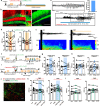Adult-born neurons in critical period maintain hippocampal seizures via local aberrant excitatory circuits
- PMID: 37280192
- PMCID: PMC10244397
- DOI: 10.1038/s41392-023-01433-4
Adult-born neurons in critical period maintain hippocampal seizures via local aberrant excitatory circuits
Abstract
Temporal lobe epilepsy (TLE), one common type of medically refractory epilepsy, is accompanied with altered adult-born dentate granule cells (abDGCs). However, the causal role of abDGCs in recurrent seizures of TLE is not fully understood. Here, taking advantage of optogenetic and chemogenetic tools to selectively manipulate abDGCs in a reversible manner, combined with Ca2+ fiber photometry, trans-synaptic viral tracing, in vivo/vitro electrophysiology approaches, we aimed to test the role of abDGCs born at different period of epileptogenic insult in later recurrent seizures in mouse TLE models. We found that abDGCs were functionally inhibited during recurrent seizures. Optogenetic activation of abDGCs significantly extended, while inhibition curtailed, the seizure duration. This seizure-modulating effect was attributed to specific abDGCs born at a critical early phase after kindled status, which experienced specific type of circuit re-organization. Further, abDGCs extended seizure duration via local excitatory circuit with early-born granule cells (ebDGCs). Repeated modulation of "abDGC-ebDGC" circuit may easily induce a change of synaptic plasticity, and achieve long-term anti-seizure effects in both kindling and kainic acid-induced TLE models. Together, we demonstrate that abDGCs born at a critical period of epileptogenic insult maintain seizure duration via local aberrant excitatory circuits, and inactivation of these aberrant circuits can long-termly alleviate severity of seizures. This provides a deeper and more comprehensive understanding of the potential pathological changes of abDGCs circuit and may be helpful for the precise treatment in TLE.
© 2023. The Author(s).
Conflict of interest statement
The authors declare no competing interests.
Figures







Similar articles
-
Direct Septum-Hippocampus Cholinergic Circuit Attenuates Seizure Through Driving Somatostatin Inhibition.Biol Psychiatry. 2020 May 1;87(9):843-856. doi: 10.1016/j.biopsych.2019.11.014. Epub 2019 Nov 26. Biol Psychiatry. 2020. PMID: 31987494
-
Functions of adult-born neurons in hippocampal memory interference and indexing.Nat Neurosci. 2019 Oct;22(10):1565-1575. doi: 10.1038/s41593-019-0484-2. Epub 2019 Sep 2. Nat Neurosci. 2019. PMID: 31477897 Free PMC article. Review.
-
Altered Synaptic Drive onto Birthdated Dentate Granule Cells in Experimental Temporal Lobe Epilepsy.J Neurosci. 2019 Sep 18;39(38):7604-7614. doi: 10.1523/JNEUROSCI.0654-18.2019. Epub 2019 Jul 3. J Neurosci. 2019. PMID: 31270158 Free PMC article.
-
Recruitment of parvalbumin and somatostatin interneuron inputs to adult born dentate granule neurons.Sci Rep. 2020 Oct 16;10(1):17522. doi: 10.1038/s41598-020-74385-2. Sci Rep. 2020. PMID: 33067500 Free PMC article.
-
On the role of somatostatin in seizure control: clues from the hippocampus.Rev Neurosci. 2003;14(3):285-301. doi: 10.1515/revneuro.2003.14.3.285. Rev Neurosci. 2003. PMID: 14513869 Review.
Cited by
-
Compensatory Regulation of Excitation/Inhibition Balance in the Ventral Hippocampus: Insights from Fragile X Syndrome.Biology (Basel). 2025 Mar 31;14(4):363. doi: 10.3390/biology14040363. Biology (Basel). 2025. PMID: 40282228 Free PMC article. Review.
-
Mitochondrial ferritin alleviates ferroptosis in a kainic acid-induced mouse epilepsy model by regulating iron homeostasis: Involvement of nuclear factor erythroid 2-related factor 2.CNS Neurosci Ther. 2024 Mar;30(3):e14663. doi: 10.1111/cns.14663. CNS Neurosci Ther. 2024. PMID: 38439636 Free PMC article.
-
Enriched Environment Reduces Seizure Susceptibility via Entorhinal Cortex Circuit Augmented Adult Neurogenesis.Adv Sci (Weinh). 2024 Dec;11(46):e2410927. doi: 10.1002/advs.202410927. Epub 2024 Oct 22. Adv Sci (Weinh). 2024. PMID: 39435757 Free PMC article.
-
Epilepsy therapy beyond neurons: Unveiling astrocytes as cellular targets.Neural Regen Res. 2026 Jan 1;21(1):23-38. doi: 10.4103/NRR.NRR-D-24-01035. Epub 2025 Jan 13. Neural Regen Res. 2026. PMID: 39819836 Free PMC article.
-
New Neurons, Fewer Seizures: Environmental Enrichment Strengthens Brain Circuits.Epilepsy Curr. 2025 Jun 25:15357597251352433. doi: 10.1177/15357597251352433. Online ahead of print. Epilepsy Curr. 2025. PMID: 40586043 Free PMC article. No abstract available.
References
Publication types
MeSH terms
LinkOut - more resources
Full Text Sources
Miscellaneous

